height VOLVO V50 2009 Owner´s Manual
[x] Cancel search | Manufacturer: VOLVO, Model Year: 2009, Model line: V50, Model: VOLVO V50 2009Pages: 286, PDF Size: 7.12 MB
Page 18 of 286
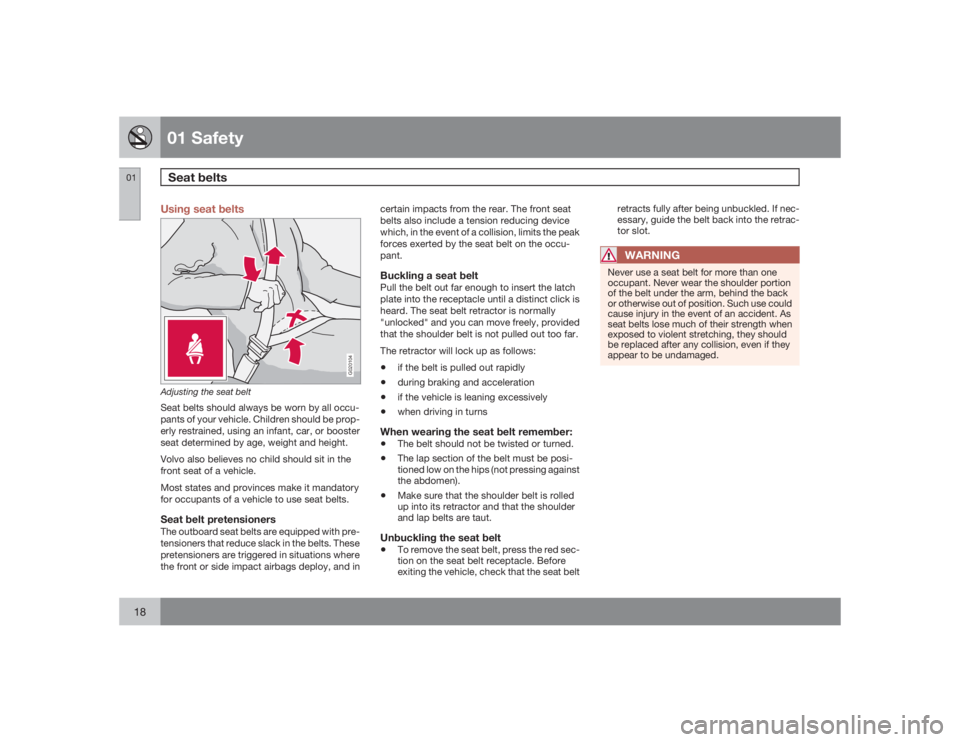
01 SafetySeat belts
0118
Using seat belts
G020104
Adjusting the seat beltSeat belts should always be worn by all occu-
pants of your vehicle. Children should be prop-
erly restrained, using an infant, car, or booster
seat determined by age, weight and height.
Volvo also believes no child should sit in the
front seat of a vehicle.
Most states and provinces make it mandatory
for occupants of a vehicle to use seat belts.Seat belt pretensionersThe outboard seat belts are equipped with pre-
tensioners that reduce slack in the belts. These
pretensioners are triggered in situations where
the front or side impact airbags deploy, and incertain impacts from the rear. The front seat
belts also include a tension reducing device
which, in the event of a collision, limits the peak
forces exerted by the seat belt on the occu-
pant.
Buckling a seat beltPull the belt out far enough to insert the latch
plate into the receptacle until a distinct click is
heard. The seat belt retractor is normally
"unlocked" and you can move freely, provided
that the shoulder belt is not pulled out too far.
The retractor will lock up as follows:•
if the belt is pulled out rapidly
•
during braking and acceleration
•
if the vehicle is leaning excessively
•
when driving in turns
When wearing the seat belt remember:•
The belt should not be twisted or turned.
•
The lap section of the belt must be posi-
tioned low on the hips (not pressing against
the abdomen).
•
Make sure that the shoulder belt is rolled
up into its retractor and that the shoulder
and lap belts are taut.
Unbuckling the seat belt•
To remove the seat belt, press the red sec-
tion on the seat belt receptacle. Before
exiting the vehicle, check that the seat beltretracts fully after being unbuckled. If nec-
essary, guide the belt back into the retrac-
tor slot.
WARNING
Never use a seat belt for more than one
occupant. Never wear the shoulder portion
of the belt under the arm, behind the back
or otherwise out of position. Such use could
cause injury in the event of an accident. As
seat belts lose much of their strength when
exposed to violent stretching, they should
be replaced after any collision, even if they
appear to be undamaged.
Page 24 of 286

01 SafetySupplemental Restraint System
0124
Customer Care Center
P.O. Box 914 Rockleigh, New Jersey
07647-0914
1-800-458-1552
www.volvocars.us
In Canada
Volvo Cars of Canada Corp.
National Customer Service
175 Gordon Baker Road
North York, Ontario M2H 2N7
1-800-663-8255
www.volvocanada.com
WARNING
•
Do not use child safety seats or child
booster cushions/backrests in the front
passenger's seat. We also recommend
that occupants under 4 feet 7 inches
(140 cm) in height who have outgrown
these devices sit in the rear seat with the
seat belt fastened
1.
•
Never drive with the airbags deployed.
The fact that they hang out can impair
the steering of your vehicle. Other
safety systems can also be damaged.
•
The smoke and dust formed when the
airbags are deployed can cause skin
and eye irritation in the event of pro-
longed exposure.
G032243
Airbag decal in the front passenger's door opening
1See also the Occupant Weight Sensor information on page 26.
Page 34 of 286
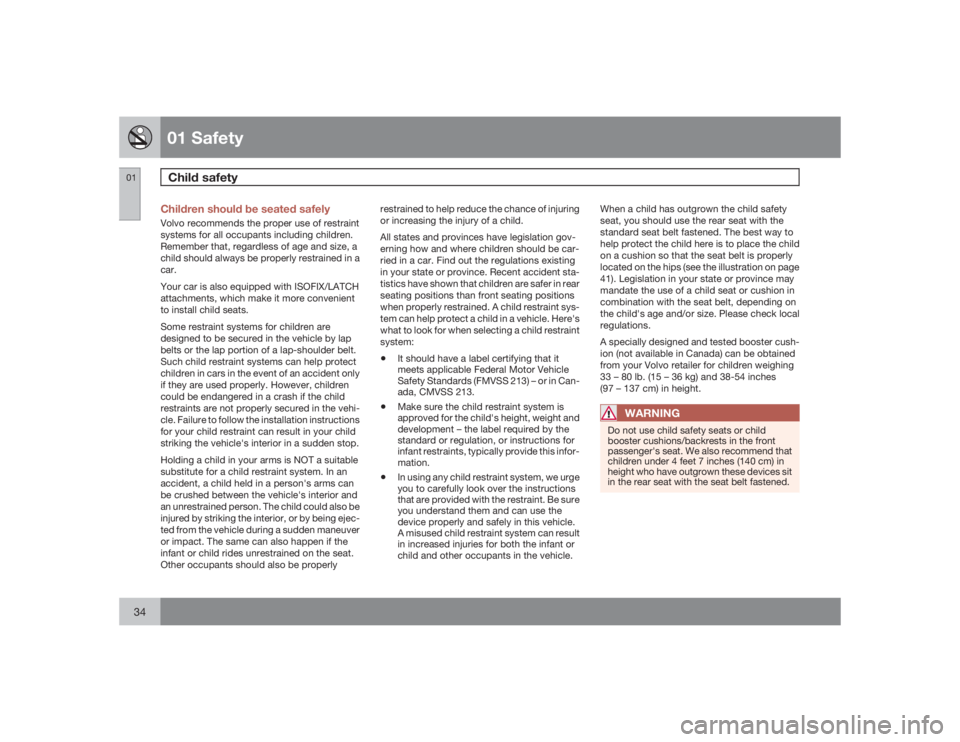
01 SafetyChild safety
0134
Children should be seated safelyVolvo recommends the proper use of restraint
systems for all occupants including children.
Remember that, regardless of age and size, a
child should always be properly restrained in a
car.
Your car is also equipped with ISOFIX/LATCH
attachments, which make it more convenient
to install child seats.
Some restraint systems for children are
designed to be secured in the vehicle by lap
belts or the lap portion of a lap-shoulder belt.
Such child restraint systems can help protect
children in cars in the event of an accident only
if they are used properly. However, children
could be endangered in a crash if the child
restraints are not properly secured in the vehi-
cle. Failure to follow the installation instructions
for your child restraint can result in your child
striking the vehicle's interior in a sudden stop.
Holding a child in your arms is NOT a suitable
substitute for a child restraint system. In an
accident, a child held in a person's arms can
be crushed between the vehicle's interior and
an unrestrained person. The child could also be
injured by striking the interior, or by being ejec-
ted from the vehicle during a sudden maneuver
or impact. The same can also happen if the
infant or child rides unrestrained on the seat.
Other occupants should also be properlyrestrained to help reduce the chance of injuring
or increasing the injury of a child.
All states and provinces have legislation gov-
erning how and where children should be car-
ried in a car. Find out the regulations existing
in your state or province. Recent accident sta-
tistics have shown that children are safer in rear
seating positions than front seating positions
when properly restrained. A child restraint sys-
tem can help protect a child in a vehicle. Here's
what to look for when selecting a child restraint
system:
•
It should have a label certifying that it
meets applicable Federal Motor Vehicle
Safety Standards (FMVSS 213) – or in Can-
ada, CMVSS 213.
•
Make sure the child restraint system is
approved for the child's height, weight and
development – the label required by the
standard or regulation, or instructions for
infant restraints, typically provide this infor-
mation.
•
In using any child restraint system, we urge
you to carefully look over the instructions
that are provided with the restraint. Be sure
you understand them and can use the
device properly and safely in this vehicle.
A misused child restraint system can result
in increased injuries for both the infant or
child and other occupants in the vehicle.When a child has outgrown the child safety
seat, you should use the rear seat with the
standard seat belt fastened. The best way to
help protect the child here is to place the child
on a cushion so that the seat belt is properly
located on the hips (see the illustration on page
41). Legislation in your state or province may
mandate the use of a child seat or cushion in
combination with the seat belt, depending on
the child's age and/or size. Please check local
regulations.
A specially designed and tested booster cush-
ion (not available in Canada) can be obtained
from your Volvo retailer for children weighing
33 – 80 lb. (15 – 36 kg) and 38-54 inches
(97 – 137 cm) in height.
WARNING
Do not use child safety seats or child
booster cushions/backrests in the front
passenger's seat. We also recommend that
children under 4 feet 7 inches (140 cm) in
height who have outgrown these devices sit
in the rear seat with the seat belt fastened.
Page 73 of 286
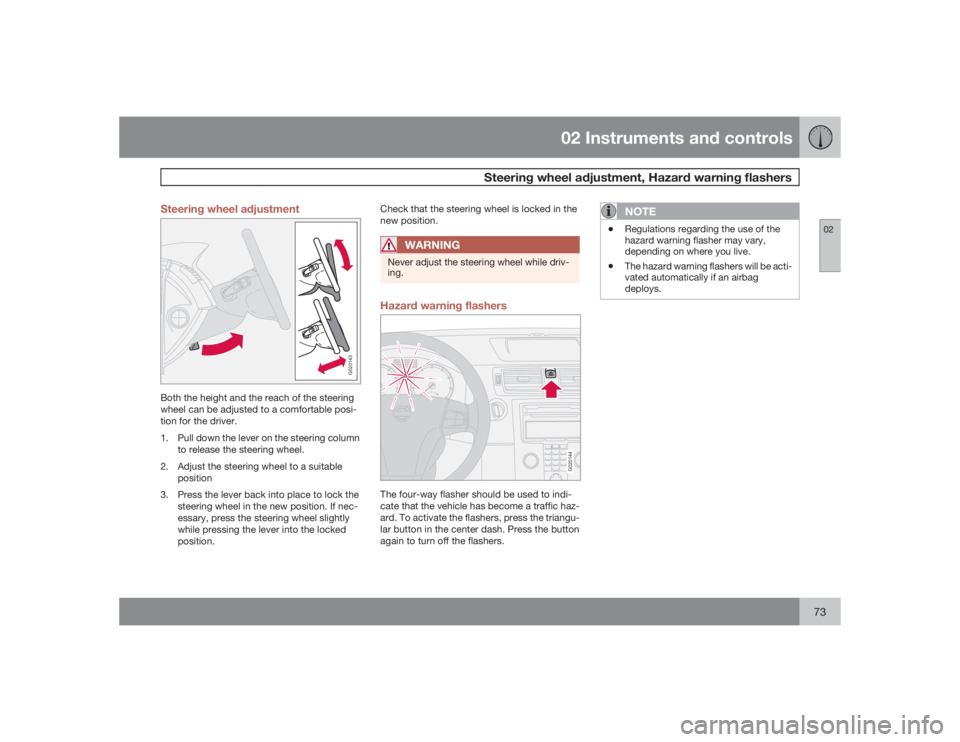
02 Instruments and controls
Steering wheel adjustment, Hazard warning flashers
0273 Steering wheel adjustment
G020143
Both the height and the reach of the steering
wheel can be adjusted to a comfortable posi-
tion for the driver.
1. Pull down the lever on the steering column
to release the steering wheel.
2. Adjust the steering wheel to a suitable
position
3. Press the lever back into place to lock the
steering wheel in the new position. If nec-
essary, press the steering wheel slightly
while pressing the lever into the locked
position.Check that the steering wheel is locked in the
new position.
WARNING
Never adjust the steering wheel while driv-
ing.Hazard warning flashers
G020144
The four-way flasher should be used to indi-
cate that the vehicle has become a traffic haz-
ard. To activate the flashers, press the triangu-
lar button in the center dash. Press the button
again to turn off the flashers.
NOTE
•
Regulations regarding the use of the
hazard warning flasher may vary,
depending on where you live.
•
The hazard warning flashers will be acti-
vated automatically if an airbag
deploys.
Page 111 of 286
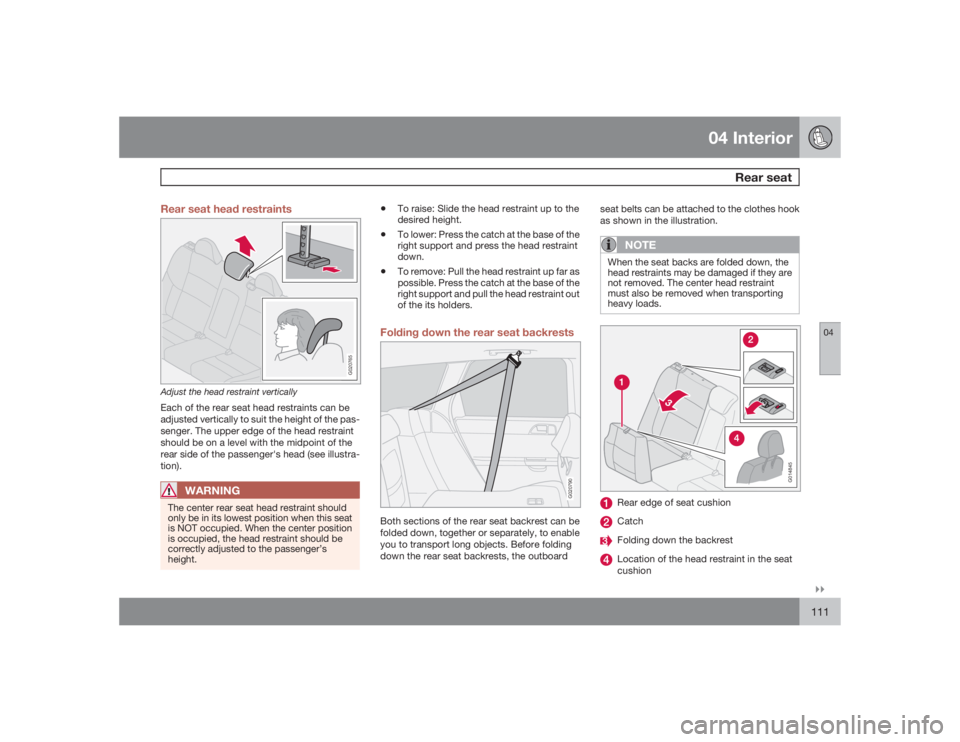
04 Interior
Rear seat
04�`�`111 Rear seat head restraints
G020765
Adjust the head restraint verticallyEach of the rear seat head restraints can be
adjusted vertically to suit the height of the pas-
senger. The upper edge of the head restraint
should be on a level with the midpoint of the
rear side of the passenger's head (see illustra-
tion).
WARNING
The center rear seat head restraint should
only be in its lowest position when this seat
is NOT occupied. When the center position
is occupied, the head restraint should be
correctly adjusted to the passenger’s
height.
•
To raise: Slide the head restraint up to the
desired height.
•
To lower: Press the catch at the base of the
right support and press the head restraint
down.
•
To remove: Pull the head restraint up far as
possible. Press the catch at the base of the
right support and pull the head restraint out
of the its holders.
Folding down the rear seat backrests
G020790
Both sections of the rear seat backrest can be
folded down, together or separately, to enable
you to transport long objects. Before folding
down the rear seat backrests, the outboardseat belts can be attached to the clothes hook
as shown in the illustration.
NOTE
When the seat backs are folded down, the
head restraints may be damaged if they are
not removed. The center head restraint
must also be removed when transporting
heavy loads.
G014845
Rear edge of seat cushionCatchFolding down the backrestLocation of the head restraint in the seat
cushion
Page 180 of 286
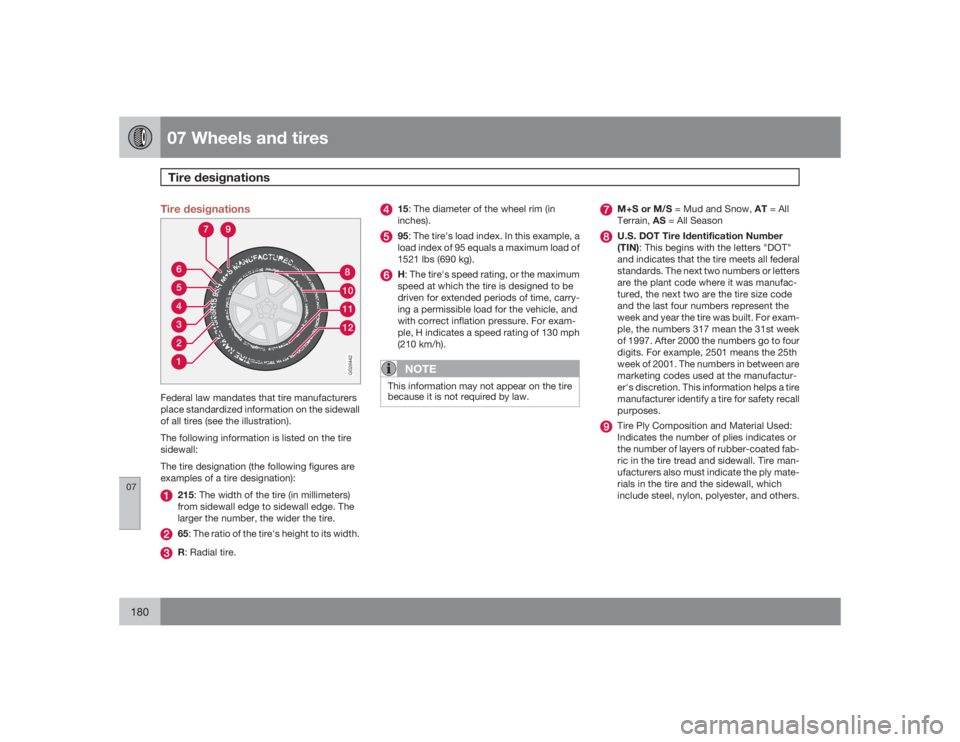
07 Wheels and tiresTire designations
07180
Tire designations
123456
1211108
7
9
G026442
Federal law mandates that tire manufacturers
place standardized information on the sidewall
of all tires (see the illustration).
The following information is listed on the tire
sidewall:
The tire designation (the following figures are
examples of a tire designation):
215: The width of the tire (in millimeters)
from sidewall edge to sidewall edge. The
larger the number, the wider the tire.65: The ratio of the tire's height to its width.R: Radial tire.
15: The diameter of the wheel rim (in
inches).95: The tire's load index. In this example, a
load index of 95 equals a maximum load of
1521 lbs (690 kg).H: The tire's speed rating, or the maximum
speed at which the tire is designed to be
driven for extended periods of time, carry-
ing a permissible load for the vehicle, and
with correct inflation pressure. For exam-
ple, H indicates a speed rating of 130 mph
(210 km/h).NOTE
This information may not appear on the tire
because it is not required by law.
M+S or M/S = Mud and Snow, AT = All
Terrain,AS = All SeasonU.S. DOT Tire Identification Number
(TIN): This begins with the letters "DOT"
and indicates that the tire meets all federal
standards. The next two numbers or letters
are the plant code where it was manufac-
tured, the next two are the tire size code
and the last four numbers represent the
week and year the tire was built. For exam-
ple, the numbers 317 mean the 31st week
of 1997. After 2000 the numbers go to four
digits. For example, 2501 means the 25th
week of 2001. The numbers in between are
marketing codes used at the manufactur-
er's discretion. This information helps a tire
manufacturer identify a tire for safety recall
purposes.Tire Ply Composition and Material Used:
Indicates the number of plies indicates or
the number of layers of rubber-coated fab-
ric in the tire tread and sidewall. Tire man-
ufacturers also must indicate the ply mate-
rials in the tire and the sidewall, which
include steel, nylon, polyester, and others.
Page 264 of 286
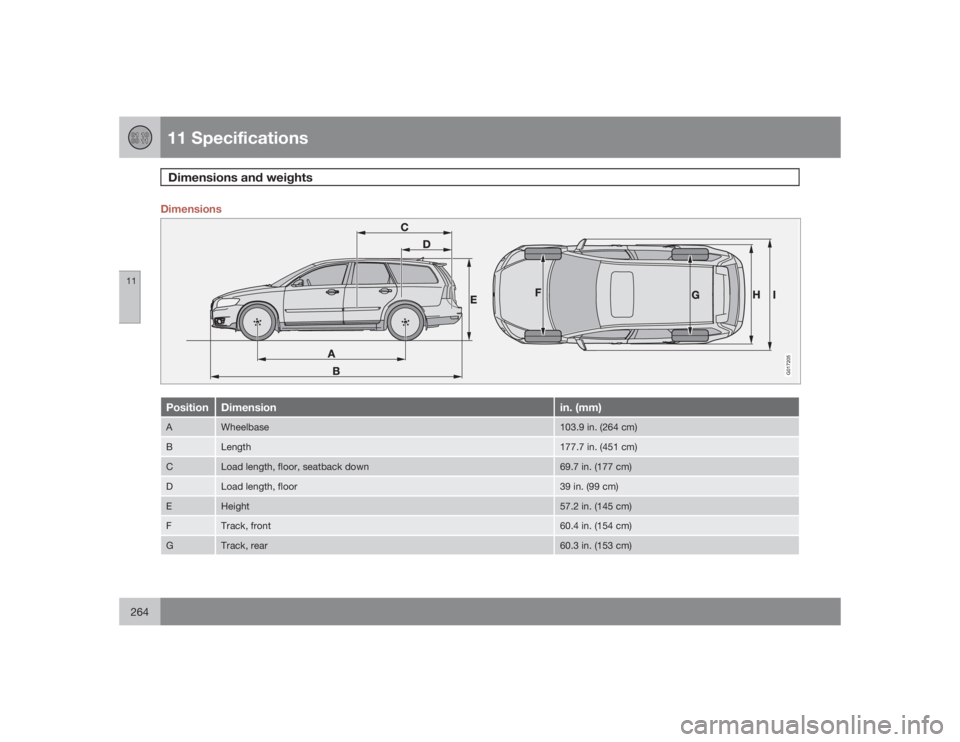
11 SpecificationsDimensions and weights
11264
Dimensions
G017205
Position
Dimension
in. (mm)
A
Wheelbase
103.9 in. (264 cm)
B
Length
177.7 in. (451 cm)
C
Load length, floor, seatback down
69.7 in. (177 cm)
D
Load length, floor
39 in. (99 cm)
E
Height
57.2 in. (145 cm)
F
Track, front
60.4 in. (154 cm)
G
Track, rear
60.3 in. (153 cm)